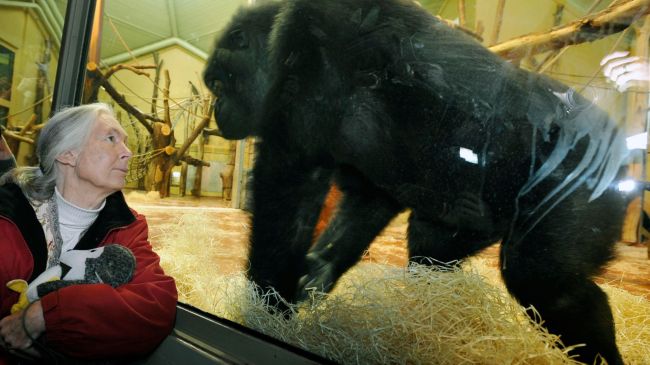Opinion Jane Goodall’s gift to us: Seeing animals as both kin and mystery
When she showed us that chimpanzees are not only creatures that echo our behaviours, but also beings whose violence, estrangement, and silence mark them as irreducibly other, she showed that similarity becomes the lens through which difference is magnified
 Jane Goodall looks at one the of gorillas at Budapest Zoo in Hungary, Feb 11, 2008. (Photo: AP)
Jane Goodall looks at one the of gorillas at Budapest Zoo in Hungary, Feb 11, 2008. (Photo: AP) On a long-ago afternoon, at the age of I-don’t-remember-what, Jane Goodall gave me something that I realised was a gift only many years later. It was a scene in a National Geographic documentary about her work with the Gombe Stream chimpanzees in Tanzania (then known as Tanganyika). In the film, amidst the many visuals of chimps grooming and screeching at each other, brawling and meditatively munching on fruits and grub, there was one that shook me: A pair stealing and killing the baby of another member of their troop and eating it.
These were animals that I had seen, until then, as mischievous and clownish, but fundamentally benign. Received from cartoons, it was an image my childish heart had held on to, despite being introduced at a young age to nature’s brutality via wildlife documentaries — “the poor lion also has to eat, no?” being a typical parental comment.
Of course, chimps were known to be clever; in the 1950s, a chimpanzee named Congo had become famous for his Jackson Pollock-style paintings (his talent had first been recognised by Desmond Morris, zoologist, artist, and author of The Naked Ape). Then along came Goodall, who discovered in the 1960s that not only are these apes able to use tools, they make them for specific purposes — an ability that was, until then, seen as being uniquely human.
But intelligence is one thing, and cunning and malevolence are quite another. What I saw in that documentary seemed to be shedding a harsh new light on animals that had seemed, for so long, like charming cousins, mischievous imitators that reflected back our gestures with endearing clumsiness. Yet here they were, in this documentary, shown waging war, ambushing the vulnerable, brutally beating and killing their “enemies” and even eating their own young.
It would be a few years before I understood the deeper truth that emerged from Goodall’s work: That animals are beings of incredible complexity, as capable of ferocity as they are of tenderness, as given to cruelty as they are to kinship. Their lives cannot be reduced to symbols of innocence or savagery. They inhabit a continuum where both are possible, and where neither can be fully explained in human terms.
For those who love animals, it is astonishingly easy to forget this. This is especially true when it comes to our pets, the animals who share our homes and lives, who eat and sleep alongside us, who depend on us for care and diversion. Perhaps, it’s only to be expected: After all, our longest animal relationship, with dogs, is even older than agriculture itself. We believe we know and understand these companions completely. A dog waits at the door, it bounds in happiness at the prospect of a walk, and looks at us with pleading eyes at the dining table — these gestures seem to speak a language of transparency.
But mystery persists — as much with dogs as with cats, horses, and all the other animals we have domesticated over the millennia. It reveals itself in the way, for example, my cats often stiffen and turn their gaze towards what appears to my eyes as empty space. What can they possibly be seeing? It can be disconcerting to realise that animals’ senses operate on frequencies we cannot enter, that their instincts are shaped by evolutionary histories we cannot possibly inhabit, even if a small, hidden part of us has always known this (as evident in ancient myths and legends, and today’s horror films and novels, about animals’ ability to perceive and communicate with worlds or dimensions beyond our ken).
This shadowland that lies between our species and others is what allows respect to flourish. If an animal could be fully translated into human terms, it would cease to be an animal — it would become a mere projection. The shimmer of mystery between us and animals is, thus, an invaluable bequest. It reminds us that reverence depends on distance as much as closeness.
This was Goodall’s gift to us. When she taught us to see chimpanzees not only as creatures that echo our behaviours — tool-users, mourners, affectionate kin — but also as beings whose violence, estrangement, and silence mark them as irreducibly other, she showed that similarity becomes the lens through which difference is magnified. To sit with this paradox is to step away from our sentimental tendency to paint animals in simple hues and enter the wilderness of their true existence. Wilderness, after all, is not just forests and rivers. It is the space between minds, the untranslatable pulse of life that will never be fully ours to decipher. In that space, wonder becomes possible.
pooja.pillai@expressindia.com






